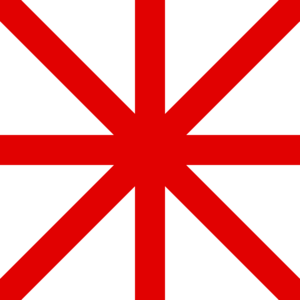Nalagqe
The Nalagqe (Naichinese: 环太阳, Ná̤lágqe [nɘ́.ɬá.kt͡ɕē]) is a Naikanghi symbol consisting of four intersecting bars, or two overlaid crosses. Some variations exist, including those suited to different aspect ratios, and some which involve widening the rays as they move away from the centre. The Nalagqe has been a symbol of the Naikanghi people and a key part of the Culture of Naikang for centuries at least, with some going so far as to assert that the symbol has, in some form, existed as a Naikanghi symbol for over two millennia. In the modern day, the Nalagqe has been used to represent the Naikanghi Ashang, leading to a somewhat controversial reputation within Naikang, though the symbol remains present on many ethnic flags of the Naikanghi people.
History
The first recorded use of the symbol was at the creation of the First Nahi Kang, in opposition to colonial endeavours and Chengshengese expansion in Beisin. There are assertions made that the symbol was already familiar to the Naikanghi, though some assert that it is a corruption of the Chengshengese symbol "丰", meaning "plenty" or "abundant", as a sign of good luck, with similar iconography found in other aspects of Nahi folk religion. Regardless of ultimate origin, the symbol saw use and familiarisation by the subsequent Second and Third Nahi Kang unions, with the symbol often displayed as a form of peaceful protest. The symbol was briefly made illegal by the colonial government, with protests against discrimination often turning violent.
